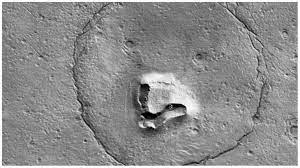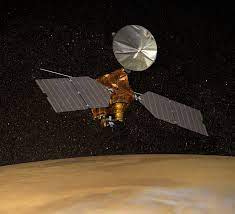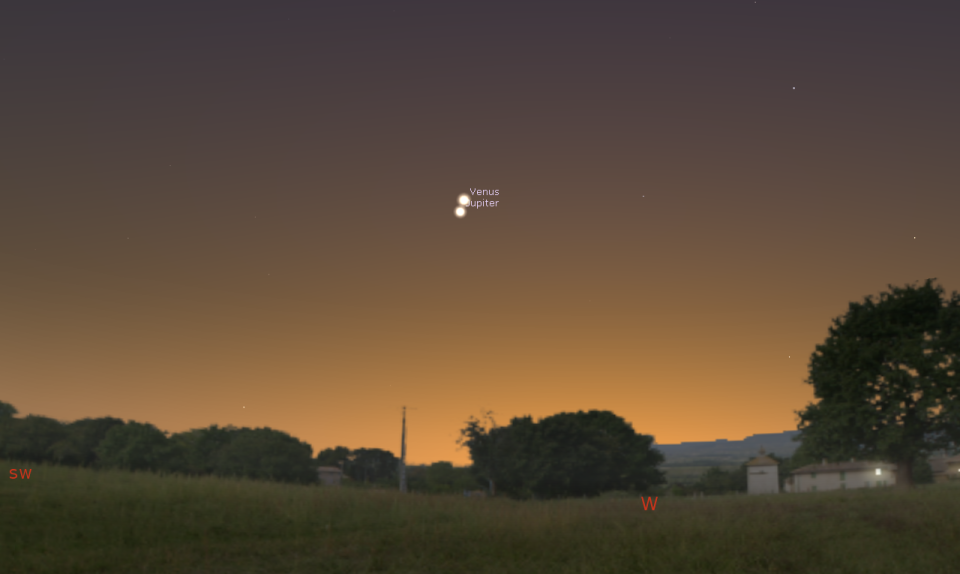Sky Shorts: Features on surface of Mars resemble a teddy bear face

On Jan. 25, the University of Arizona shared an adorable picture of a feature on the surface of Mars that resembles a teddy bear’s face.
The image was captured by the HiRISE camera aboard the Mars Reconnaissance Orbiter (MRO) on Dec. 12, 2022, 155 miles above the surface. The MRO was launched in 2005 and reached Mars in 2006 with a mission goal to search for water and ice on the surface of Mars and advance our understanding of Mars through detailed observation.
There are six science instruments onboard with the HiRISE camera being one of those instruments. HiRISE is the most powerful camera telescope ever flown to another planet.

More Sky Shorts:Space exploration, night sky highlights for 2023
From time to time, when reviewing the MRO images, scientists come across images that resemble faces, like the teddy bear face. Our brains have evolved to detect faces quickly, so we tend to see faces everywhere, like the man on the Moon or the face on Mars, captured by Viking 1, in July 1976.
A few years ago, scientists discovered another feature, courtesy of the HiRISE camera aboard the MRO, that resembled the face of Beaker, the Muppet. I still share the Beaker picture in my planetarium programs!

Along with seeing faces, our human brains see patterns in random or unrelated objects or patterns, too. This phenomenon is called pareidolia, which is recognized as part of normal human experience.
We all experience from time to time assigning human characteristics to objects. This ability to see shapes or make pictures out of randomness indicates things which we are most interested in.
A perfect example is if you have ever laid back and looked at big white puffy clouds on a blue-sky day. Surely, you have imagined pictures in those clouds, such as dogs, cats or dragons. I once imagined Albert Einstein’s face and hair in a cloud!
Living long ago, before TV’s, computers and video games, ancient civilizations would lay under a starry sky and create pictures by connecting stars. They created stories for their pictures and that is how they entertained their friends and families. But their stars patterns also helped them understand time, when to plant, harvest or prepare for winter.
Each culture imagined different pictures based on animals in their area and traditions. Each culture has its own interesting pictures and stories.
On the next clear night, find the constellation Orion, the Hunter in the southern sky. Orion, the Hunter is located on the celestial equator and can be seen throughout the world. Imagine how many different cultures gazed at this star pattern. Each culture had a different name and story for that magnificent group of stars.
Also for the next week, head out and enjoy the two brightest planets, Venus and Jupiter come together for a phenomenal show in the western sky after sunset.

Night Sky for March
Planets and the Moon:
March opens with the stunning show of Venus and Jupiter in the western sky. Venus is shining at magnitude -3.9, while Jupiter shines at -2.1.
Venus is dazzling and can be seen, if you know where to look, right before sunset. The pair starts at half a degree apart on March 1 and the gap grows to 30 degrees by month’s end. Jupiter continues to sink lower and Venus higher through the month.
The crescent moon makes a lovely pairing with Jupiter on March 22 and with Venus on the following evening.
Mars can be found in Taurus, the Bull. It will outshine the bright star Aldebaran for most of the month, but will continue to fade, ultimately matching the magnitude of Aldebaran by month’s end. Mars will cross into Gemini, the Twins on March 26.
The first quarter moon passes by Mars on March 28. There will be two binocular opportunities to see Uranus. On March 24, you will find Uranus about one degree south of the crescent moon.
Then March 30, Uranus will be one-degree due south of Venus. Mercury moves back to the evening sky late this month, very low in the west right after sunset. On March 27, 30 minutes after sunset, Jupiter and Mercury will be on degree apart very low in the west. You will need to have a clear view of the western horizon to view this pairing.
Saturn returns to the morning sky and by month’s end, rises over an hour before dawn. Neptune is not visible in March.
Remember to spring your clocks ahead for daylight savings time on March 12 and the Vernal Equinox, or first day of spring, begins at 5:24 pm. March 20.
Constellations
Southwest: Orion, the Hunter, continues to march westward through March. Look for the three stars in a line, which make up the belt of Orion. The bright red-orange star up and to the left of the belt is Betelgeuse. The bright blue-white star down and to the right of the belt is Rigel. Draw a line up from the belt to a red, orange star, Aldebaran, which is the eye of Taurus, the Bull. The sideways V shape is the face of Taurus. Above Taurus, the small cluster of stars is the Pleiades or Seven Sisters. Making a counterclockwise loop from the Pleiades, the next bright star is Capella. Continuing down, the two stars you see are Gemini, the Twins.
North: The Big Dipper is swinging higher in the sky. Following the two stars at the end of the cup to the next bright star is Polaris, or the North Star. The constellation Cassiopeia is to the left of Polaris and resembles a sideways letter "M.”
East: Head back to the cup of the Big Dipper. Locate the flat part of the cup. Look to the right for the shape of a backward question mark. This is the head of Leo, the Lion. Towards the end of March, arc off the handle of the Big Dipper to the bright yellow, orange star Arcturus.
Binocular Highlights: Facing west, you will see the small cluster of stars, the Pleiades, or the Seven Sisters. The Pleiades is a beautiful open star cluster. Head to Orion, the Hunter. Scan below the three stars of Orion’s belt. You will see fuzzy area with bright stars. This is the Orion Nebula, a hydrogen gas cloud where new stars are forming. For a challenge, scan between Leo and Gemini. There you will find the Beehive Star Cluster.
For further night sky details, maps and audio, visit my website www.starrytrails.com.
Visit the Hoover Price Planetarium
Visit www.mckinleymuseum.org, for show dates and times. Planetarium shows are free with museum admission. The planetarium is inside the McKinley Presidential Library & Museum, 800 McKinley Monument Drive NW, in Canton. For more information, call the museum at 330-455-7043.
This article originally appeared on The Repository: Sky Shorts: Features on surface of Mars resemble a teddy bear face

